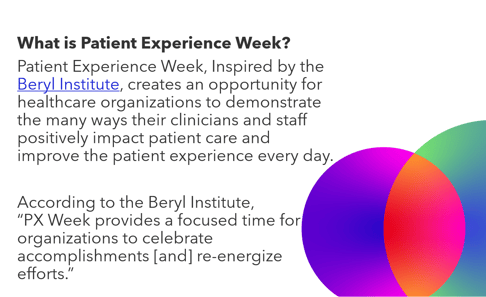
Patient experience—the sum of all interactions that influence patients’ perceptions of the healthcare they receive—is an important component of healthcare quality for patients, certainly. For health systems and providers, it affects factors ranging from workforce satisfaction to reimbursement under value-based payment models. Enhancing the patient experience is even one of the goals of the Quadruple Aim.
The COVID-19 pandemic altered the lens through which both patients and provider organizations view their experiences. In celebration of Patient Experience Week, April 25-29, we’re focused on how patient experience has changed—and how healthcare organizations can improve it.
Is patient experience the same as patient satisfaction?
Although the terms patient experience and patient satisfaction are often used interchangeably, they are not the same. Both measure patients’ view of healthcare quality, access, safety, and more, but patient experience better measures patients’ range of interactions with multiple touch points of the healthcare system. As we discussed in a blog, patient experience targets the factors that matter most to patients (e.g., getting timely appointments, easily accessing their healthcare information, and good communication with their providers). The Hospital Consumer Assessment of Healthcare Providers and Systems (HCAHPS) Survey measures patients’ perceptions of their hospital experience.
According to the Agency for Healthcare Quality and Research, assessing patient experience means asking patients whether something that should happen during their healthcare visit (such as clear communication with a provider) actually happened or how often it happened.
Satisfaction measures whether a patient’s expectations about their care were met. Patients who receive the exact same care—but have different expectations for how that care should be delivered—can have different satisfaction scores because of their varying expectations.

What's the value of patient experience?
Understanding and evaluating patient experience is essential for improving healthcare quality and moving toward patient-centered care. By examining patients’ interactions with providers before, during, and after their care episode, healthcare organizations can assess the extent to which patients receive care that meets their individual preferences, needs, and values.
Value-based payment models reimburse healthcare providers based on the quality—not quantity—of care delivered. CMS’ Hospital Value-Based Purchasing (VBP) Program adjusts payments to hospitals under the Inpatient Prospective Payment System (IPPS) based on care quality. The program encourages hospitals to improve the safety, efficiency, quality, and patient experience of care that Medicare patients receive during inpatient stays by:
- Eliminating or reducing adverse events
- Adopting evidence-based care standards to provide the best outcomes
- Changing hospital processes to improve the patient experience
- Publicly sharing care quality metrics with consumers and clinicians
In fiscal year 2021, the VBP Program’s value-based incentive payments were based on a hospital’s total performance score (split equally at 25% each) on four measures:
- Clinical outcomes
- Person and community engagement (i.e., patient experience measured by HCAHPS scores)
- Safety
- Efficiency and cost reduction
Eight HCAHPS measures/dimensions are included in the person and community engagement score:
- Communication with nurses
- Communication with doctors
- Staff responsiveness
- Communication about medicines
- Discharge information
- Care transition
- Cleanliness and quietness
- Hospital rating
How COVID-19 changed patient experience
A May 2021 survey of 1,000 patients found that 59% of patients say they have been interacting differently with their healthcare providers than they did before the pandemic. More than a third (38%) used telehealth in the past 18 months, and 51% of Millennials (those 19-39 in age) rank telehealth in their top three methods of preferred care.
Patients want easier, "better" provider interaction
Many patients (i.e., healthcare consumers) expect convenient, fast interactions with healthcare providers. The survey found that:
- 71% of respondents wish their healthcare experiences “were as easy as their experiences in other areas of life, like online shopping.” Digital communication is important for many patients, especially younger ones.
- 68% of patients said their healthcare providers need to improve how they interact with patients.
- Live, human interactions are the top choice. When communicating with their healthcare provider, many patients—particularly Baby Boomers (those 57-75 in age) and Gen X (those 42-57 in age)—prefer talking on the phone (62%) or in person (50%). These live communication modes are the top choices of younger patients as well, but Millennials and Gen Z patients (those 10-25 in age) are more interested than older patients in communicating via mobile app/patient portal and online chat.
Digital communication is key to success
SymphonyRM (now called Actium) surveyed almost 1,200 American healthcare consumers to determine how the COVID-19 pandemic affected patients’ engagement preferences. The survey results indicated that patient expectations, particularly regarding communication, have changed since the pandemic began. Half (50%) of survey respondents have higher expectations for their physician since COVID. More than half (58%) now expect digital appointment scheduling, proactive communication (57%), and virtual appointments (54%).
Healthcare organizations that communicate with patients frequently via digital channels have an advantage over those that do not. Fifty-eight percent of patients who have more confidence in their doctor following the pandemic cite frequent communication (educating them on how to prevent COVID-19 infection) as a main reason for their increased confidence. Forty-seven percent stated that providers using digital tools such as text and email to communicate about appointments and check-in boosted their confidence.
Nearly one in five patients (17%) are considering changing doctors based on how their current provider handled interactions during COVID-19. Patients who are shopping for a new doctor are prioritizing communication. According to the Actium survey, 63% of patients contemplating switching doctors say they will consider whether potential providers use digital communication tools before choosing a new doctor.
How to improve the patient experience
Deploy a digital front door
A digital front door refers to digital interactions that facilitate patient search and selection of a provider and booking an appointment. Patients choose the right provider based on their medical condition, location, whether that provider takes their health insurance, has appointments available, and other personal preference factors. Current, accurate provider directory information is essential.
Provide digital options for every touchpoint in the patient’s journey. Patients should have opportunities to use digital tools to find a physician, schedule an appointment, receive appointment reminders, check in for the appointment, and make a follow up appointment with a specialist, if needed.
Your health system’s digital front door strategy should include six general elements:
- Provider profiles
- Provider directories
- Patient portal
- Social media
- Third-party listings
- Online appointment scheduling
Provide multi-channel communication. Offer multiple low-tech (e.g., phone, mail) and digital (e.g., email, secure text message, secure messaging via your online portal, chatbot) communication options. Doing so allows you to meet patients in their preferred communication channel. Allow patients to check in digitally via your patient portal.
Offer/expand telehealth services—especially for primary care
Telehealth use soared during the pandemic, with over 32% of total outpatient visits occurring via telehealth in April 2020. Although its use has declined since then, telehealth utilization has stabilized at levels 38 times higher than pre-pandemic, with 17% of visits occurring virtually. Consumer and provider attitudes toward telehealth have improved, and so has reimbursement.
According to one survey, nearly 90% of patients across all generations—except Baby Boomers—prefer, or are open to, telehealth for primary care. Therefore, it’s imperative for health systems to offer phone and video options for telehealth visits, to accommodate individual preferences.
Use a quality management dashboard to track patient experience
Quality management dashboards increase the visibility and transparency of key quality data targets and measures, including adverse events, clinical outcomes, patient access, and patient experience. Nurse leaders and others compare this internal performance data with other departments, facilities in the system, and other healthcare organizations (via healthcare industry benchmarks), to identify areas for quality improvement. You can assess patients’ experiences and perceptions of their healthcare by tracking complaints and administering patient experience surveys, including HCAHPS.
Train providers on effective communication
Given the importance of patients’ communication with doctors and nurses (regarding treatment planning, medications, discharge instructions, and more), it’s important for providers to develop exceptional communication skills. Providers may benefit from training in these communication strategies/models:
- AIDET communication tool. The five fundamentals of patient communication are: Acknowledge, Introduce, Duration, Explanation, and Thank You.
- RESPECT model. This approach focuses on Rapport, Empathy, Support, Partnership, Explanations, Cultural Competence, and Trust.
Enlist symplr to help you start planning for better patient—and provider—experience today. 